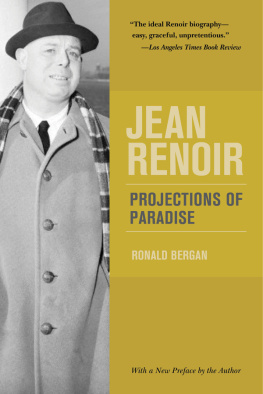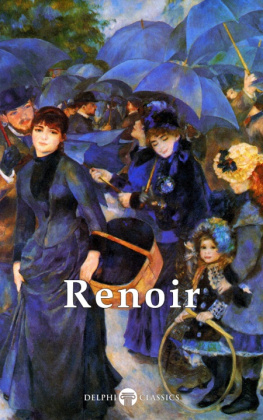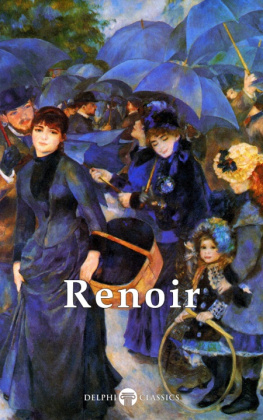Pascal Merigeau - Jean Renoir
Here you can read online Pascal Merigeau - Jean Renoir full text of the book (entire story) in english for free. Download pdf and epub, get meaning, cover and reviews about this ebook. year: 2017, publisher: Running Press, genre: Detective and thriller. Description of the work, (preface) as well as reviews are available. Best literature library LitArk.com created for fans of good reading and offers a wide selection of genres:
Romance novel
Science fiction
Adventure
Detective
Science
History
Home and family
Prose
Art
Politics
Computer
Non-fiction
Religion
Business
Children
Humor
Choose a favorite category and find really read worthwhile books. Enjoy immersion in the world of imagination, feel the emotions of the characters or learn something new for yourself, make an fascinating discovery.

- Book:Jean Renoir
- Author:
- Publisher:Running Press
- Genre:
- Year:2017
- Rating:4 / 5
- Favourites:Add to favourites
- Your mark:
- 80
- 1
- 2
- 3
- 4
- 5
Jean Renoir: summary, description and annotation
We offer to read an annotation, description, summary or preface (depends on what the author of the book "Jean Renoir" wrote himself). If you haven't found the necessary information about the book — write in the comments, we will try to find it.
Jean Renoir — read online for free the complete book (whole text) full work
Below is the text of the book, divided by pages. System saving the place of the last page read, allows you to conveniently read the book "Jean Renoir" online for free, without having to search again every time where you left off. Put a bookmark, and you can go to the page where you finished reading at any time.
Font size:
Interval:
Bookmark:
2016 Pascal Mrigeau
Cover Photo: Courtesy Everett Collection
Originally published in France by Flammarion 2012
English-language edition published by RatPac Press in collaboration with Running Press,
An Imprint of Perseus Books, LLC., A Subsidiary of Hachette Book Group, Inc.
All rights reserved under the Pan-American and International Copyright Conventions
This book may not be reproduced in whole or in part, in any form or by any means, electronic or mechanical, including photocopying, recording, or by any information storage and retrieval system now known or hereafter invented, without written permission from the publisher.
RatPac Press logo is a registered trademark of RatPac Press, LLC.
Books published by Running Press are available at special discounts for bulk purchases in the United States by corporations, institutions, and other organizations. For more information, please contact the Special Markets Department at Perseus Books, 2300 Chestnut Street, Suite 200, Philadelphia, PA 19103, or call (800) 810-4145, ext. 5000, or e-mail special.markets@perseusbooks.com.
ISBN 978-0-7624-5596-6
Library of Congress Control Number: 2016957798
E-book ISBN 978-0-7624-5608-6
Edited by Cindi Rowell and Cindy De La Hoz
Designed by Joshua McDonnell
Typography: Bembo and Brandon
RatPac Press
4000 Warner Blvd.
Burbank, CA 91522
Running Press Book Publishers
2300 Chestnut Street
Philadelphia, PA 19103-4371
Visit us on the web!
www.ratpacentertainment.com
www.runningpress.com
Translators note: This book was first published in France, where the American title of a film, play, or book first appearing in France had no relevancy for the text. For this edition of the book, I have researched the English-language titles, if different, for works that also appeared in the United States; and these most often appear inserted in parentheses throughout this text.
E3-20161219-JV-NF
In memory of Alain Renoir
(October 31, 1921December 12, 2008)
I was born with the itch to tell stories. When Id wail in my cradle, it was in hopes of attracting an audience.
Jean Renoir, December 1972,
Unused epigraph for My Life and My Films
There are very few artists in the history of movies who are undeniable. Jean Renoir is one of those few. If youre dealing with cinema, youre dealing with Renoir. Youre seeking out his films, watching them, rewatching them, understanding them. And, inevitably, marveling at them.
Renoir brought something to the art of moviemaking that is still so fresh and surprising that his pictures feel like they were just made, just invented . Near the end of his life, D. W. Griffith said, Whats missing from the movies nowadays is the beauty of the moving wind in the trees . He was talking about American cinema at the height of the studio system. But, of course, Renoirs cinema was and isthe moving wind in the trees, the flowing water of a stream, the faces of Jean Gabin and Simone Simon as lovers ashamed of their actions, the eccentric movements of Louis Jouvet as a nobleman reduced to a state of poverty, the red cheeks of a young girl at a social dance, a kite caught in a tree, childish pride on the face of Marcel Dalio as a rich aristocrat, clouds over the skies of Paris. I dont mean to imply that Renoir just strung moments togetherhe was a storyteller, and a great one. But he was a storyteller of a particular kind. He found and told stories that allowed for life to flow through and over and under the events onscreenthe little surprises and harmonies and beauties of character and atmosphere and light that make up experience. The River, which I suppose is my favorite of Renoirs films and one of the greatest pictures Ive ever seen, could be described simply as the story of an English girl growing up in India. But the movie is everything that happens between the moments of the coming-of-age story. Like every Renoir picture, its about life, lived moment by moment, every moment coming together and then dissolving in the flow of time.
So much has been written about Renoir over the years. We have his own wonderful book My Life and My Films . We have the great Andr Bazins book, finished after his death by Franois Truffaut and his fellow writers and filmmakers-to-be. We have biographies and critical investigations and personal remembrances. And now we have this thorough, probing, exhaustively researched biography, which sets a new standard. Pascal Mrigeau gives us a portrait of Renoirs life that is more recognizably human than any weve previously had. Of course Renoir sanded off the rough edges of his life, as Mrigeau puts it. All of us do the same, I think. And Renoirs imperfections and vanities only bring him closer to us, and to the experience of his extraordinary and eternally wondrous films.
Late on the morning of February 20, 1979, Jean Renoir was interred in the family vault in Essoyes cemetery, next to his older brother, Pierre, and their father, Auguste. His mother, Aline, and younger brother, Claude, lay nearby.
It was cold that Tuesday. The ground was frozen, the roads icy; the few faithful whod come to pay their respects to the memory of the Master worried theyd never make it as far as Essoyes. Driven by Jean Carmet who voiced his certainty that the Boss wouldnt have had it otherwise, the little group swept into a caf as soon as arriving and ordered ham and eggs, which were served at the exact moment the funeral procession crossed the square. That same evening in Neuilly, Dido and Alain Renoir, the widow and only son of the director, reminisced about the deceased over a leg of lamb with beans, a specialty of Sbillon, the restaurant Renoir had frequented in the old days.
Jean Renoir had died at lunchtime on February 12, the Monday of the week before, in his house on Leona Drive in Beverly Hills Benedict Canyon. He was eighty-four years old. On Friday the sixteenth, a mass had been celebrated at the oldest church in Beverly Hills, Church of the Good Shepherd, the same one that had hosted Rudolph Valentinos funeral in 1926 and Gary Coopers in 1961 as well as the place where George Cukor had staged the funeral scene in the film A Star Is Born; and where, a little more than a year after Renoirs service, respects would be paid to Alfred Hitchcock, who would die on April 29, 1980. On the evening of Sunday the twenty-fifth, two thousand people visited the enormous Royce Hall at the University of California, Los Angeles (UCLA) for a ceremony in Renoirs honor, which had been planned some time before but had been transformed into a posthumous tribute at which Cukor, among others, spoke.
On the day after Renoirs death, deep within the part of the country where hed spent his childhood vacations, he was honored on a scale worthy of his renown, just as would happen in California, where hed lived the last thirty-eight years of his life. That renown was sizable, motivated as it was by admiration for his films, the aura of his personality as the son of a great painter, his reputation for openness to the world and to others, and his extraordinary lust for life and all the pleasures it affordedamong which those of the table ranked high. And so, another leg of lamb serves as a way to begin this story.
Alain Renoir had spent a long time preparing the dish, using a tiny knife to make the incisions into which he inserted slivers of garlic. Unearthing from a cupboard an electric rotisserie whose functioning only he knew, and cursing the appliance without really being annoyed, he finally plugged it in; soon after, it glowed red. He didnt take his eyes from the meat while it cooked, unless to serve himself a glass of champagne. Alain Renoir loved champagneFrench brands when he was in France, Californian when he was at home. That evening, or perhaps the day before, or the day before that, hed discovered one of the two films of his father that he hadnt known:
Font size:
Interval:
Bookmark:
Similar books «Jean Renoir»
Look at similar books to Jean Renoir. We have selected literature similar in name and meaning in the hope of providing readers with more options to find new, interesting, not yet read works.
Discussion, reviews of the book Jean Renoir and just readers' own opinions. Leave your comments, write what you think about the work, its meaning or the main characters. Specify what exactly you liked and what you didn't like, and why you think so.










